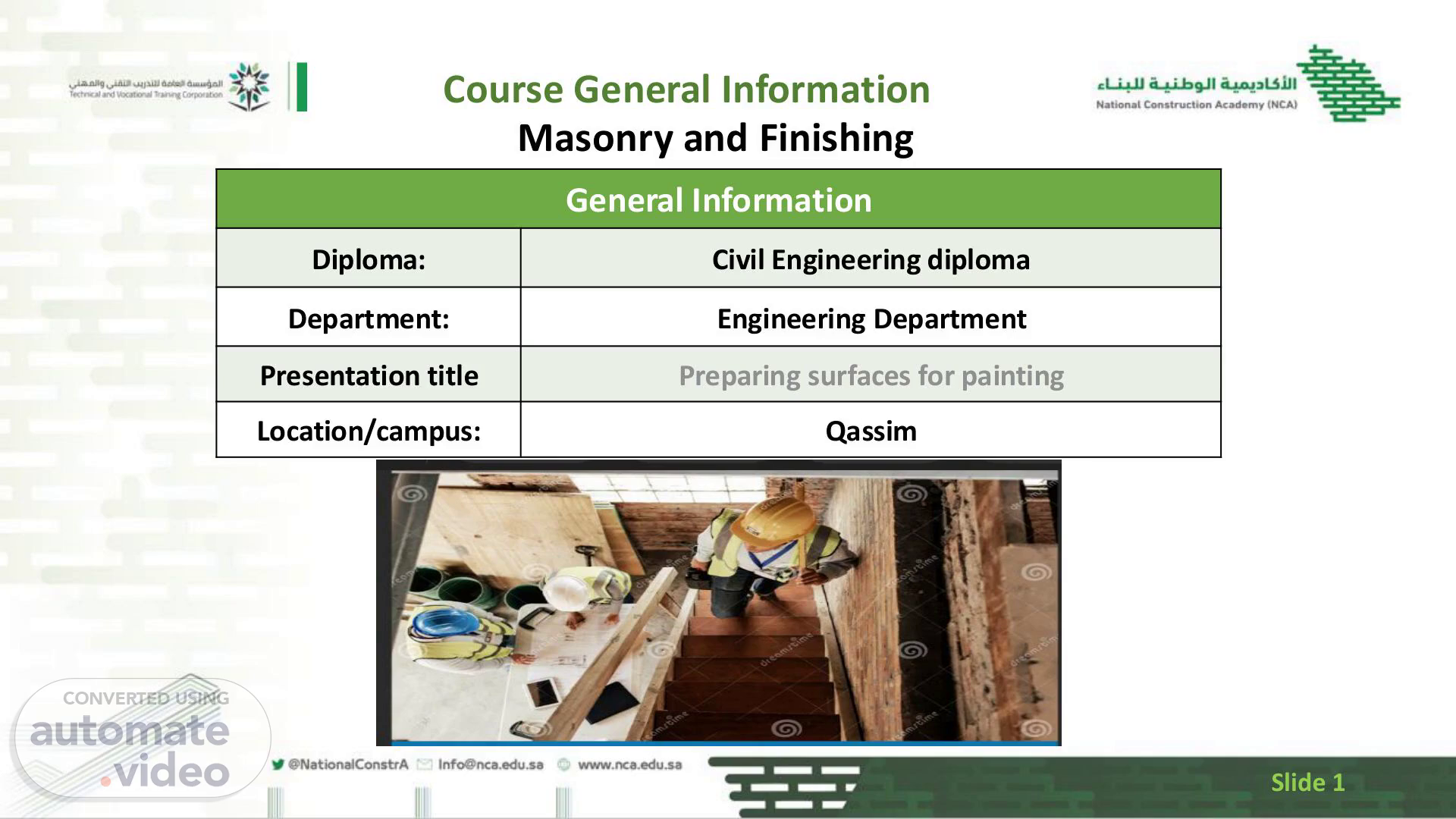Scene 1 (0s)
[Audio] Course General Information Masonry and Finishing General Information Diploma: Civil Engineering diploma Department: Engineering Department Presentation title Preparing surfaces for painting Location/campus: Qassim Slide 1.
Scene 2 (15s)
[Audio] introduction This process ensures that the paint adheres well, enhances Tools needed for the Proper surface preparation is crucial for achieving a highdurability, and provides a preparing wall for painting quality paint finish in smooth and even construction. appearance. Neglecting surface preparation can lead to paint failures such as peeling, Understanding the key steps and techniques involved in preparing surfaces will help ensure successful painting cracking, and uneven projects coverage. Slide 2.
Scene 3 (50s)
[Audio] Lesson Objectives Understand the importance of surface preparation in painting projects. Identify the key steps involved in preparing surfaces for painting. Learn about the tools and materials needed for effective surface preparation. Recognize common issues that arise from inadequate surface preparation. Apply best practices for ensuring successful paint adhesion and finish. Slide 3.
Scene 4 (1m 17s)
[Audio] Key Words 1. Surface Preparation: The process of cleaning, repairing, and priming surfaces before painting to ensure optimal adhesion and finish. 2. Priming: Applying a preparatory coating to improve paint adhesion, seal the surface, and enhance the durability of the finish. 3. Caulking: Filling gaps and cracks with a sealant to create a smooth surface and prevent moisture intrusion. 4. Patch Repair: The process of filling holes and damaged areas with a suitable material to restore surface integrity. 5. Adhesion: The ability of paint to stick to the surface, which is influenced by surface preparation and conditions. Slide 4.
Scene 5 (2m 7s)
[Audio] Importance of surface preparation Surface preparation is It enhances the A well-prepared surface crucial for ensuring durability of the finish, promotes a uniform coat, resulting in a more proper paint adhesion, which prevents peeling protecting against moisture and UV aesthetically pleasing and chipping. damage. appearance. Additionally, taking the time to prepare can Finally, thorough preparation helps save money by reducing future maintenance needs. identify any underlying issues, ensuring a longlasting and successful paint job. Slide 5.
Scene 6 (2m 46s)
[Audio] Key steps in preparation Inspect the Surface: Check for cracks, damage, and signs of mold or mildew. Clean the Surface: Remove dirt, dust, and grease using a pressure washer or scrub brush with appropriate cleaning solutions. Repair Damage: Fill cracks and holes with suitable fillers, and sand down any rough areas. Remove Loose Paint: Use a paint scraper or wire brush to eliminate any flaking or peeling paint Slide 6.
Scene 7 (3m 16s)
[Audio] Key steps in preparation Prime the Surface: Apply a suitable primer to enhance adhesion and block stains. Degrease (if necessary): For surfaces with grease, use a degreaser to ensure a clean base for painting. Allow to Dry: Ensure the primer is completely dry before applying paint. Tape and Protect Surrounding Areas: Use painter's tape to mask off edges and cover areas that should not be painted. Slide 7.
Scene 8 (3m 47s)
[Audio] Key steps in preparation youtu bWuM Slide 8.
Scene 9 (3m 55s)
[Audio] Tools needed for preparation Pressure Washer or Hose: For cleaning the surface effectively. Scrub Brush: For manual scrubbing of tough dirt or mold. Paint Scraper or Putty Knife: To remove loose paint and debris. Caulking Gun: For applying caulk to fill cracks and gaps. Masonry Filler: To repair larger cracks and holes. Slide 9.
Scene 10 (4m 19s)
[Audio] Tools needed for preparation Sanding Block or Sander: To smooth rough surfaces. Paint Roller and Brush: For applying primer and paint. Drop Cloths: To protect the surrounding area from paint splatter. Painter's Tape: For masking off areas that should not be painted. Bucket: For mixing and carrying cleaning solutions or paint. Slide 10.
Scene 11 (4m 46s)
[Audio] Materials needed for preparation youtu bWuM Slide 11.
Scene 12 (4m 54s)
[Audio] Materials needed for preparation 1.Masonry Primer: Specifically designed to adhere to masonry surfaces. 2.Masonry Paint: Durable paint formulated for use on masonry. 3.Cleaning Solution: Mild detergent or specialized masonry cleaner. 4.Caulk: Waterproof caulk for sealing gaps and cracks. 5.Masonry Filler: For repairing larger cracks and holes. Having these tools and materials on hand will help ensure an effective and efficient surface preparation process for painting masonry block walls. Slide 12.
Scene 13 (5m 33s)
[Audio] Issues faced when preparing walls and good practice Common issues from inadequate surface preparation include poor paint adhesion, leading to peeling and chipping, as well as uneven finishes that result in blotches or streaks. Moisture trapped beneath the paint can cause bubbling and mold growth, compromising the integrity of the wall. To ensure successful paint adhesion, it's essential to thoroughly clean the surface, repair any damage, and apply a suitable primer. Following these best practices will promote a durable, even finish and extend the lifespan of the paint job. Slide 13.
Scene 14 (6m 13s)
[Audio] Questions What are the primary benefits of properly preparing a masonry block wall before painting? List three essential tools needed for surface preparation of masonry walls. What is the first step in the surface preparation process for painting? Why is it important to apply a primer before painting a masonry surface? What common issues can arise from inadequate surface preparation? Describe the best practice for ensuring successful paint adhesion on masonry surfaces Slide 14.
Scene 15 (6m 44s)
[Audio] Conclusion In conclusion, proper surface preparation is essential for achieving a durable and aesthetically pleasing paint finish in construction. It involves cleaning, sanding, priming, and repairing surfaces to ensure optimal paint adhesion. By following best practices and using the right tools, painters can prevent common issues and enhance the longevity of the paint job. Understanding the preparation process not only saves time and resources but also contributes to the overall quality of construction projects. Investing in thorough surface preparation ultimately leads to better results and customer satisfaction. Slide 15.
